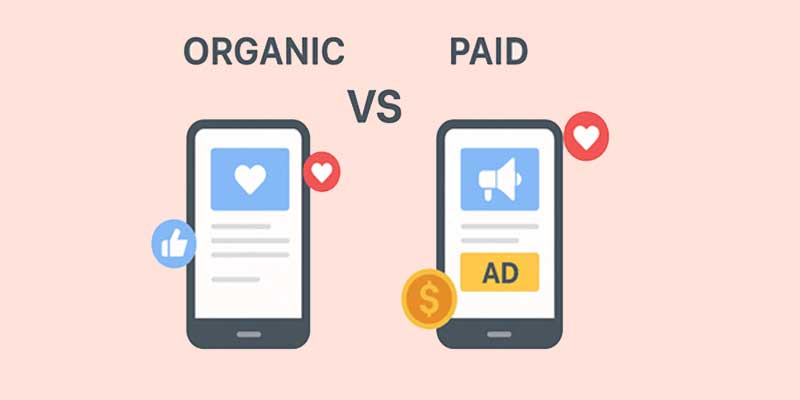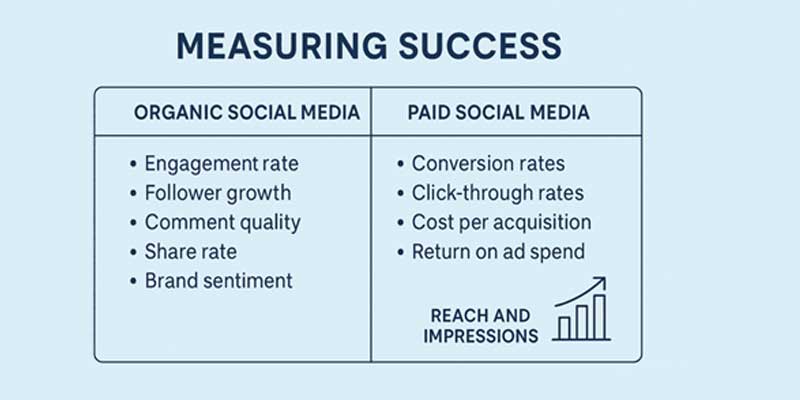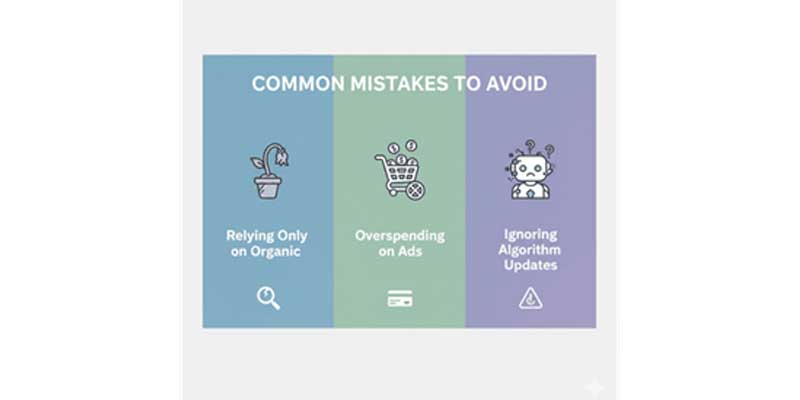

Social media has become an indispensable tool for modern businesses, but many struggle with a fundamental question: Are they going to utilize natural growth on social media platforms or go for paid social media advertisement? It can greatly affect the company’s online visibility, marketing expenses, and strategic outcomes.
The current status of social networks has reached some level of sophistication that was not easy to come by. Authentic a nd organic social media distribution used to be the primary method of getting in front of target audiences; however, due to changes in the algorithm and the amount of noise, it is tough to get a post seen by thousands of people without the help of a PPC agency in Bangalore. But this does not in any way suggest that organic social media has no value any longer – the work that it does may have changed though.
Organic social media stands as the primary basis of branding activity online. It refers to producing and posting content that naturally appears in the feeds of your followers without needing boosts or endorsements. Unlike paid campaigns, this approach focuses on genuine content creation and distribution that encourages interaction, sharing, and long-term engagement.
In essence, organic social media is about relationship-building with the audience—where every post, story, or reply builds credibility, trust, and brand presence over time.
Organic social media marketing is now giving way to paid social media marketing, which has become a go-to strategy for companies that aim to get quick results and reach only the most desirable audiences. In contrast to organically posted content, paid campaigns can also target exactly the users based on such parameters as sex, age, interests, behavior, and previous experiences with your company.
However, paid social media marketing may be tricky, depending on the company’s budget and planning on how to tackle it. Without the right targeting and good content, you may end up using your money to post on the wrong people or land on the right people and post poorly. Secondly, paid campaigns often cease to produce results after their designated budget of funds is depleted while organic content is capable of creating results in the long run.
Organic social media relies on platform algorithms to distribute posts to followers and, occasionally, to a wider audience if content sparks engagement. However, visibility is limited since most platforms prioritize sponsored content. Paid social media, on the other hand, ensures instant exposure by pushing posts directly into the feeds of targeted users, regardless of whether they follow the brand. In short, organic creates depth of engagement while paid guarantees breadth of reach.
Organic content is essentially free to post but requires consistent time, creativity, and resources to maintain. Its ROI is realized in the form of long-term brand credibility and customer loyalty. Paid social campaigns, however, come with a direct financial investment but deliver measurable results—clicks, conversions, and leads—within a defined budget. While organic provides compounding returns over time, paid campaigns can quickly demonstrate ROI through performance metrics like CPC, CPL, or ROAS.
Organic reach is largely restricted to existing followers and their networks, which makes it ideal for nurturing communities and sustaining brand relationships. Paid social allows precise audience targeting based on demographics, interests, behaviors, and lookalike modeling. This advanced targeting gives businesses the power to reach entirely new segments, making paid strategies a must for growth-oriented campaigns.
With organic strategies, results are gradual—it can take months of consistent posting, engagement, and optimization to build significant traction. Paid social, however, delivers immediate results. Campaigns can be launched, optimized, and scaled in real-time, providing quick feedback loops for marketers to test and refine. For businesses needing short-term impact, paid social clearly holds the advantage.
Audiences often perceive organic content as more authentic and credible because it isn’t directly “sponsored.” When followers engage with a brand’s organic posts, it builds a sense of community and trust that paid ads alone can’t replicate. Paid social, while effective for conversions, sometimes carries skepticism as users are aware it’s promotional. The best strategy combines both—using organic to nurture brand trust and paid to accelerate visibility and performance.
Choosing between organic and paid social media depends heavily on what your brand is trying to achieve and how much you can invest. It is equally the case that one has to treat different objectives as entirely dissimilar if one is to expect to employ different approaches to achieving them. Engagement and brand recognition may perform well on organic social media, while lead generation and quick sales usually need paid social media advertising assistance.
For brands focused on awareness, community building, and long-term authority, organic is often the preferred path because it emphasizes trust and sustained engagement. However, if the goal is immediate conversions, lead generation, or time-sensitive offers, paid campaigns provide faster and more predictable results.
Budget also plays a defining role. Opt for an approach that you can afford and that your team can handle. Organic social media takes a lot of time and constantly posts but it does not demand many monetary resources. Social media paid marketing requires capital investment and skilled professionals to handle the promotions. Smaller businesses with limited budgets may lean towards organic, while enterprises or growth-focused startups often allocate funds for paid campaigns.
Timeframe is another critical factor in deciding between organic and paid. When do you need your results back? Organic Social Media marketing takes time and is long-lasting but paid Social Media Marketing is useful for timely promotions and new product launches.
The most effective strategy is often a hybrid—leveraging paid media for quick wins and organic efforts for sustainable brand growth.
The most effective social media strategies don’t treat organic and paid as separate silos—they integrate them across the entire marketing funnel.
By combining both approaches, brands achieve the trust of organic engagement with the scalability of paid campaigns, ensuring each stage of the funnel works in harmony.
One of the most powerful ways to merge organic and paid strategies is through retargeting. While organic content attracts and nurtures an engaged audience, not all users convert right away. Paid ads step in to retarget those who have already interacted with your organic posts, website, or videos, ensuring that warm leads aren’t lost.
At the same time, organic engagement—replying to comments, sharing user-generated content, and hosting community discussions—reinforces brand authenticity. When retargeted ads appear alongside these organic touchpoints, the result is a consistent brand experience that feels less like advertising and more like relationship-building.
In practice, this means:
This balanced approach maximizes ad efficiency, nurtures community loyalty, and ensures that marketing dollars are spent on audiences already primed to convert.

Measuring the success of organic social media is about tracking engagement and community growth. Key metrics include:
These metrics highlight how well your brand is earning attention without paid boosts and demonstrate long-term brand equity.
Paid social media metrics are more transactional and focused on conversions. Critical KPIs include:
These paid performance metrics provide immediate, measurable insights into how effectively campaigns are driving results and revenue.
To create a holistic view of performance, brands need to track shared KPIs that apply across both organic and paid efforts:
By aligning shared KPIs with business objectives, brands can see the bigger picture, ensuring organic and paid strategies complement each other rather than operate in isolation.
Artificial intelligence is transforming how brands deliver content on social media. In 2025, AI personalization goes beyond suggesting posts—it analyzes browsing history, engagement behavior, and purchase intent to serve hyper-relevant content. Brands leveraging AI can customize messages at scale, ensuring that each follower sees content tailored to their preferences. This not only increases engagement but also enhances conversion rates by delivering the right message to the right person at the right time.
Social platforms are no longer just communication tools; they are becoming full-fledged shopping destinations. In 2025, features like in-app checkout, live shopping, and product tagging make it easier for customers to purchase directly without leaving the platform. For businesses, social commerce bridges the gap between brand storytelling and instant sales, allowing organic posts and paid ads to directly drive revenue. This trend makes it essential for brands to optimize product catalogs, integrate seamless checkout experiences, and adopt influencer-driven commerce strategies.
Video continues to dominate social media, but in 2025, short-form and interactive videos are at the center of audience engagement. Platforms prioritize reels, stories, and live sessions because they keep users on-screen longer. Brands that adapt with snackable, mobile-friendly videos will see higher reach and engagement compared to static posts. Beyond awareness, video also drives stronger emotional connections, making it a powerful tool for both organic storytelling and paid promotions.
As global regulations tighten and users demand greater control of their data, 2025 marks the rise of privacy-first advertising. Platforms are reducing reliance on third-party cookies and shifting to first-party data, consent-based tracking, and contextual targeting. For marketers, this means finding creative ways to engage audiences without violating trust—through transparent practices, value-driven content, and reliance on zero-party data like surveys or interactive polls. Brands that embrace privacy-first strategies will stand out as trustworthy and future-ready.

Many brands make the mistake of depending exclusively on organic social media to fuel growth. While organic builds trust and fosters long-term relationships, relying on it alone often limits reach due to algorithm restrictions. Businesses that avoid investing in paid strategies may find their growth curve frustratingly slow. The smarter approach is to blend organic for credibility and paid for scalability, ensuring visibility and engagement go hand in hand.
On the flip side, some businesses over-invest in paid campaigns while neglecting the value of authentic content. Overspending on ads without creative testing, clear targeting, or nurturing organic engagement can drain budgets with minimal return. Paid campaigns are powerful but must be managed with strategy—optimizing audience segments, monitoring performance, and balancing spend with high-quality organic content. This ensures that every rupee spent contributes to both short-term conversions and long-term brand value.
Social media platforms continuously evolve, with algorithm updates dictating what content gets visibility. Brands that ignore these updates risk losing reach, engagement, and relevance. For instance, prioritization of short-form video or privacy-first ads can significantly impact campaign outcomes. Staying updated and adapting strategies—whether organic posting styles or paid ad formats—keeps businesses ahead of competitors. Agility in responding to algorithm shifts is no longer optional; it’s essential for survival in 2025.
With time the differentiation between organic and paid social media marketing may gradually be erased as it continues to mature. However, the fundamental principles will likely remain the same: organic content is the process of creating content that is relevant to the interest of the brand and audience, while paid promotion is the process of advertising your content to the target audience.
The best way to market your business across the different social media platforms is through integrated organic social media and paid social media marketing. Organic promotion should be the initial platform to use and get a large following; paid promotion should be utilized for specific targets and to give more impact to the message.
It is important to note that winning a campaign in social media marketing doesn’t take a side between the two; it is about combining the best of both for your business. In both types of efforts, whether it is organic or paid, the best approach is that there’s consistency in the message portrayed to the target market and the information the target customers are offered.
Organic social media marketing agencies in Bangalore can create a perfect marketing strategy that will bring measurable great results along with people’s trust in your business.